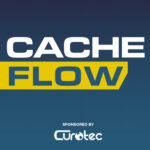In this riveting episode, Palash Soni, CEO of Gold Cast, shares his bold journey from an HBS dropout to tech startup success. His company, revolutionizing B2B marketing with AI video campaigns, thrived amid Covid uncertainty, defied odds with rapid growth, and now raises questions about the future of SaaS innovation. Tune in to dive into his riveting tales, fundraising adventures, and insights on crafting a venture that stands out in the saturated software market.
Here are a few topics we’ll discuss on this episode of Cache Flow Podcast.
- Palash details Gold Cast’s emergence in 2020.
- Harvard dropout bets big on AI video SaaS.
- Growth hack: Calendar invites boost attendance.
- Goldcast’s branding edge over competitors.
- Second product’s success signifies an inflection.
- Founders grapple with a saturated SaaS future.
Resources:
Connect with Palash Soni:
Connect with our host, Brian Dainis:
Quotables:
- 10:22 – We didn’t have Visas to work with and it was, you know, 2020 May Republican government. So we had to get through visas and we also were kind of perceived as late to market even though the market was created two months back. But just because so many people had raised so much money, all of a sudden we were under a lot of scrutiny, like a lot of questions around why this company should exist. So, the other angle was that we had the stick-in-neck problem of we needed money or VCV money to get a visa. The only way we could get a visa is this visa called an O-1 visa. Some people like advertise it as Einstein Visa, which it is not called by the US government, but it’s essentially for entrepreneurs or PhDs or people who are doing outstanding work in their fields.
- 13:07 – The equation for me and for everyone has flipped in the last two years to saying, okay, what, like, VC money is not a given and it should only be raised when there is a venture scale opportunity to go after. And we are still figuring that out. We have a very strong thesis around having an end-to-end video platform that can change the game for marketers and enterprises, but it’s still early, like it’s a decently complicated product piece that we are building. So we have early proof points that we can raise another round and justify that valuation. But yeah, we need proof stuff out before we race. So the short answer is we will, we are on that path, but it’s not the only path we can take.
- 27:01 – So we actually preach the opposite, Brian, that you should not just have MQLs as the end goal of webinars. So what we say and what we do also in our own motion is that webinars are part of like a bigger content motion, right? So the, the most results from webinars is obtained when you do it, and then you let the content live in many other places and operationalize that content in ways where it can generate value.
- 24:00 – I do think that the chasm is starting to be crossed with AI B2B, AI products. I think, you know, businesses are starting to move from, you know, starting to move from early adopters to like early majority with AI products. So it might be, if my, you know, assumption there is correct, it might be a good time in the next couple of years to really sell it.
- 42:04 – Same thing is with software, right? It’s all the obvious opportunities have been picked off in the last 10 years. Even the most non-obvious have been picked off. So as a result, I think two things are happening, which at least I see anecdotally and then probably data will verify it, is that it is also, it has become a lot more, it’s a, it’s become a lot harder for younger founders to succeed in SaaS because you genuinely need a lot of depth and, and tribal knowledge of having worked in an enterprise or having been super deep in some, some area to actually come up with an insight that can lead to a venture scale product. So that’s one. And in general, I think that realization dawned on a little late on everyone including founders and venture community that this is not the 1960s, this is like the 1990s of cars, but the underwriting of everything in the Zera era was being done as if it’s 1960s. So that led to all of this over-digestion of capital. I do think with AI there is a new pool of opportunities that is coming in.





